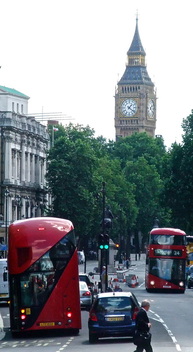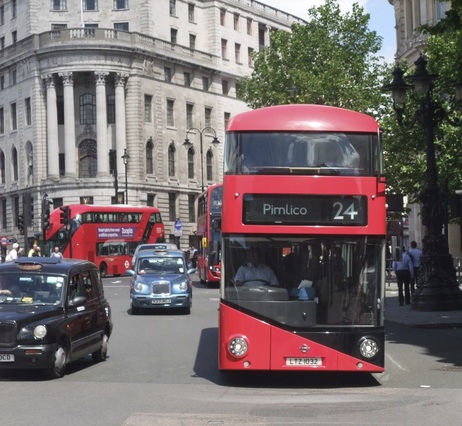 Photo by Oliver Marshall 2014
Photo by Oliver Marshall 2014 The Routemaster is a new take on an old and much-loved design, retaining the open entrance at the back and the spiral staircase to the upper deck.
The open back deck means that passengers can jump on and off at will again (although I once did that and left my young daughter behind on the platform because she was too frightened to jump - she's never forgiven me for the terror she felt as the bus pulled away...).
 Photo by Oliver Marshall 2014
Photo by Oliver Marshall 2014 There are three sets of doors in the new model – front, middle, and the open one at the back. Accessibility is far better than on the old model: there is wheelchair and buggy access and a wheelchair bay opposite the middle doors. Both audio and visual stop announcements help everyone, not just those with hearing or visual impairments.
Production of the old Routemasters stopped in 1968. The new Routemasters, which hit London's roads in 2012, were designed by Thomas Heatherwick, who also designed the beautiful copper cauldron at the 2012 London Olympics.
The new model is larger than the old one but lighter, and to minimise the perceived size the corners and edges were rounded. The windows are ribbons of glass that curve around the sides and back of the bus, and the interior is simplified, less chaotic. The diesel-electric hybrid means it’s probably gentler on the environment. It certainly is less noisy.
 Photo by Oliver Marshall 2014
Photo by Oliver Marshall 2014 “A long span bridge, as needed to cross the Thames at this point, is a pure expression of engineering structure. A city centre footbridge, however, is equally about people and the environment - a piece of public architecture."
 Poster by Paul Catherall for Transport for London 2014
Poster by Paul Catherall for Transport for London 2014 And bus lanes make it possible for the no 11 to get through heavy mid-afternoon traffic.
And things like wheelchair ramps, which make our streets and pavements accessible to everyone. These all require designers who apply design to everyday life. My brother-in-law Ken is one such designer; he works as an engineer for the City of San Francisco and is in charge of ramps and other urban access.
 Anti-Homeless Spikes, V&A. Photo by Margaret Doyle 2014
Anti-Homeless Spikes, V&A. Photo by Margaret Doyle 2014 This was just months after Crisis, the homeless charity, reported that sleeping rough has increased by 75% in the past three years.
The spikes, and the 3D-printed gun that sits alongside, are the dark side of design. But there are many, many more examples of the good, the design that helps us inhabit and move freely around our public spaces.
“Design is a mirror to our society: what we buy, how things are made, how we solve problems. The things in this gallery are evidence of social, political, technological and economic change, and they show that objects mean more than their sometimes modest material value.” (V&A)


 RSS Feed
RSS Feed
